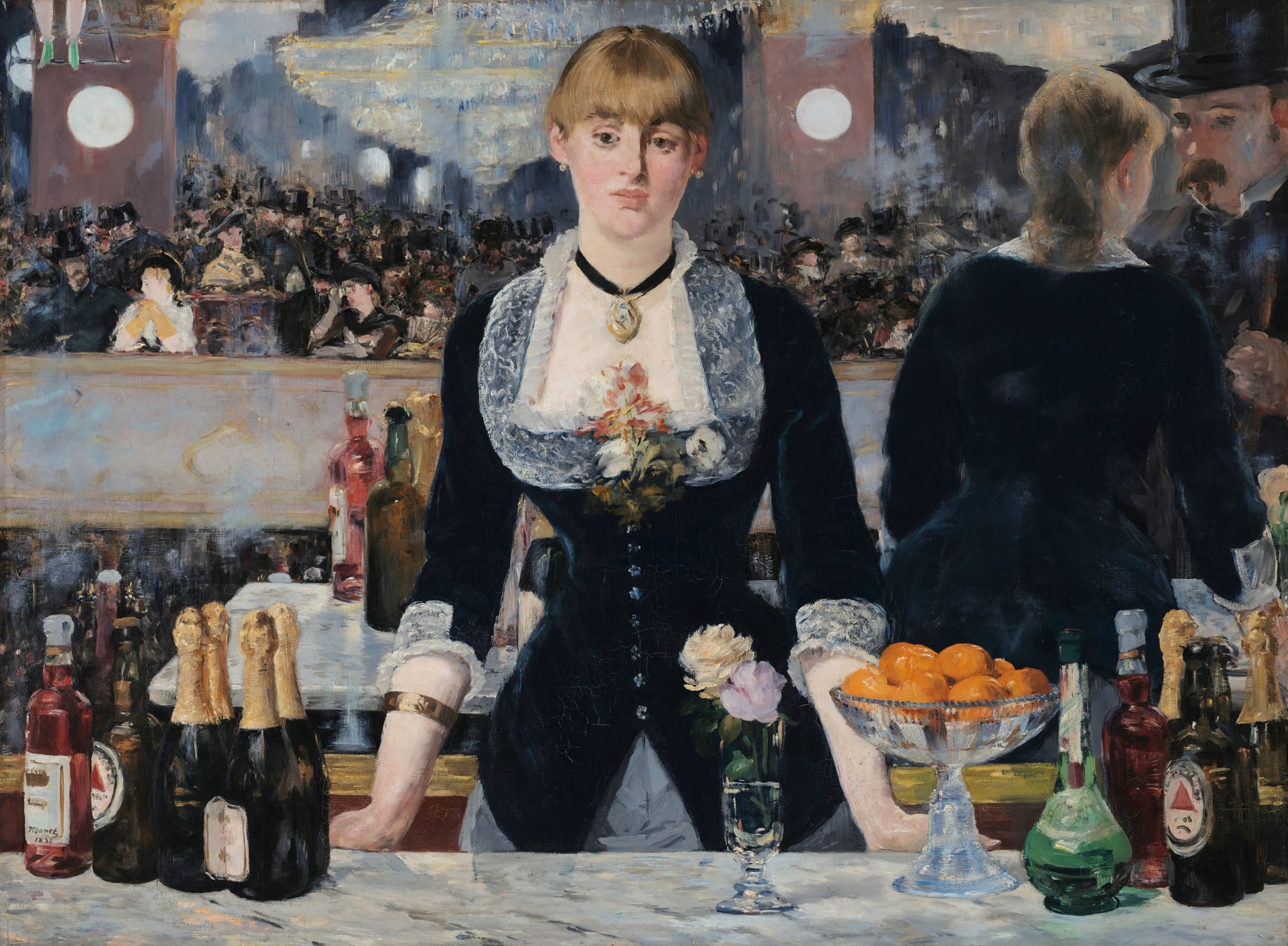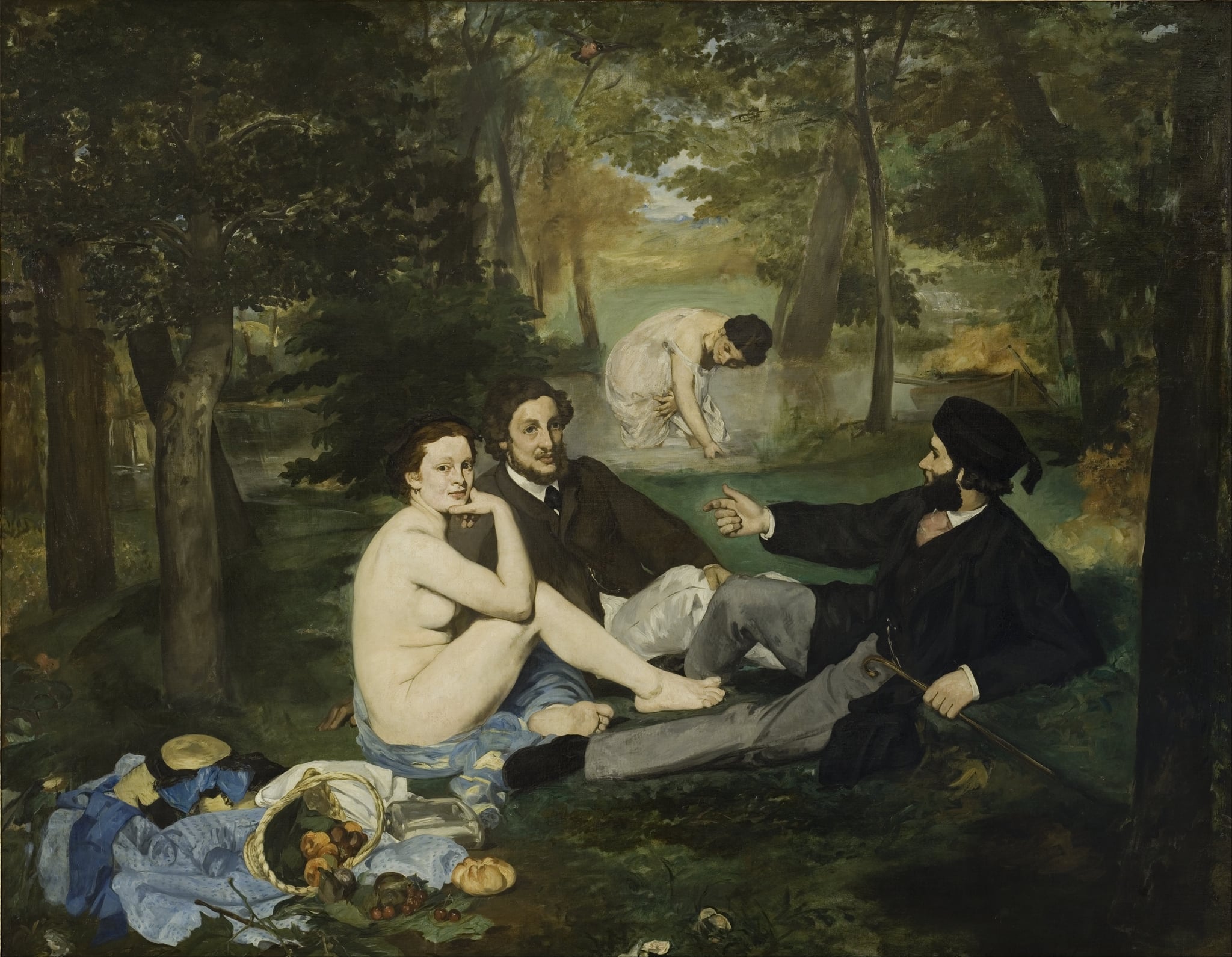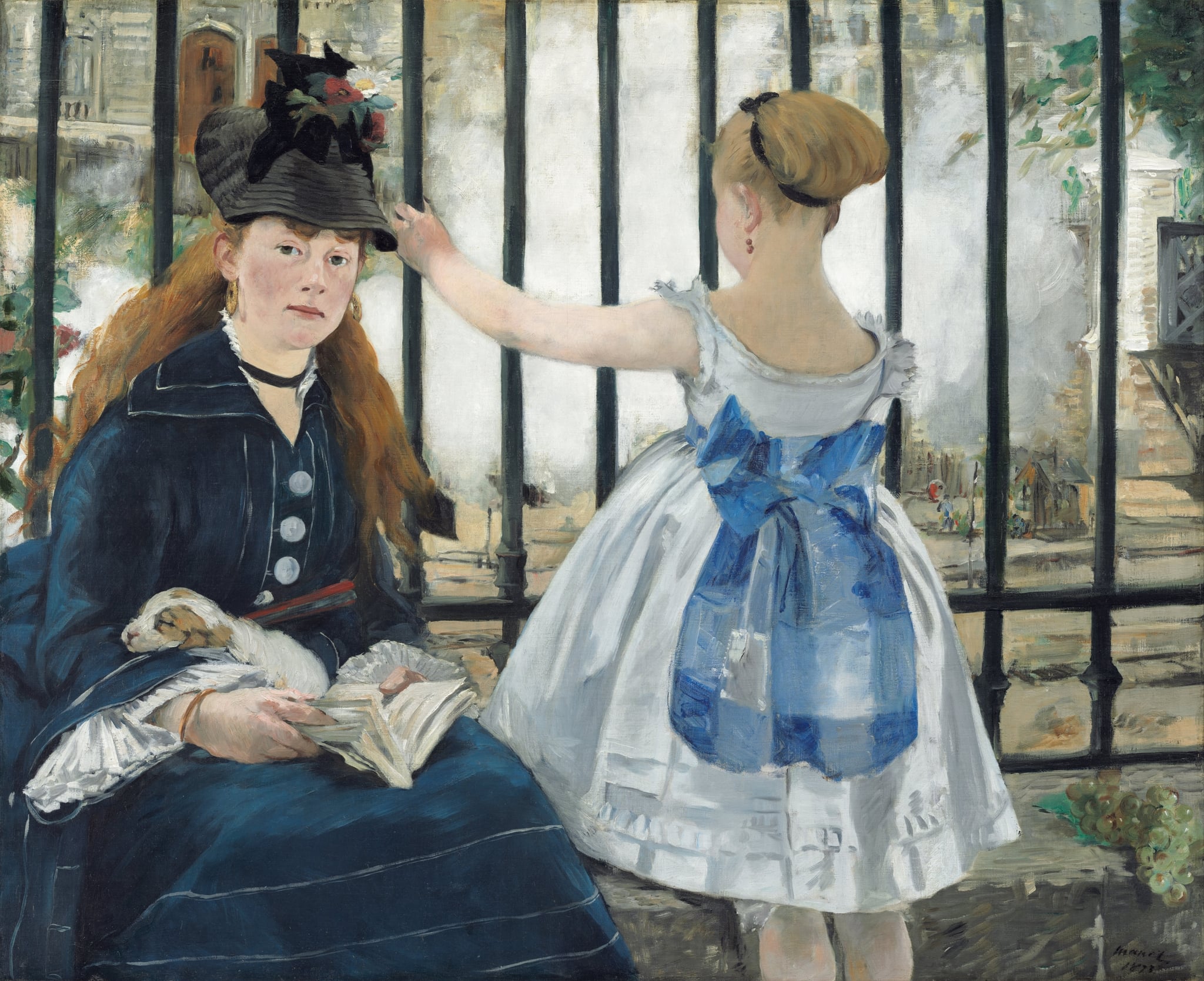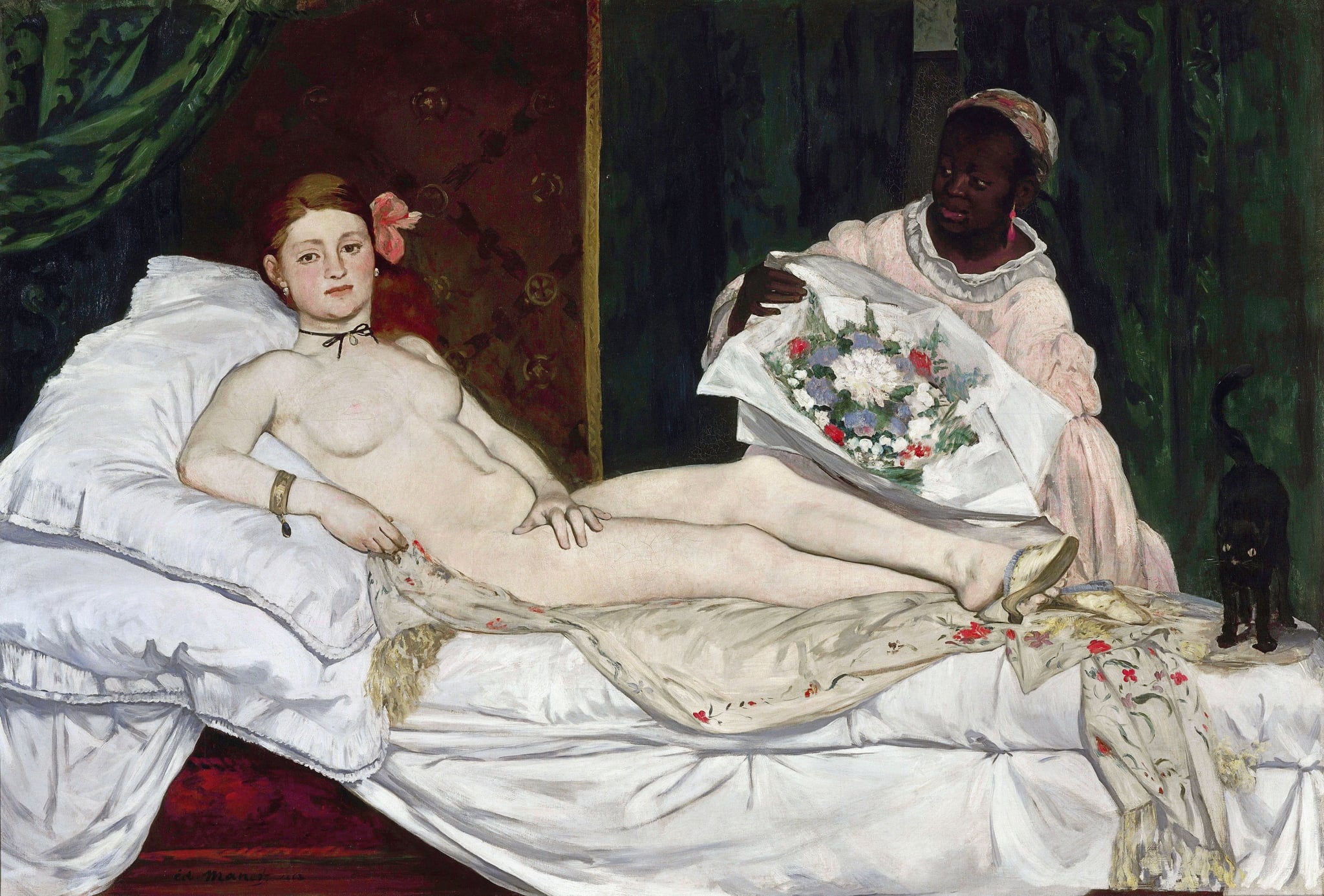Édouard Manet
Biography
Themes in Their Work
Featured in Essays

Essay
The Wheatfield Myth: Van Gogh’s Stormiest Painting Isn’t a Suicide Note
Scroll any feed and you’ll meet this image: a blasted-blue sky, a road that forks and dies, black birds like shrapnel. The caption is almost always the same: his last canvas, his farewell. Our shiver becomes the story.

Essay
Renoir’s Sweetest Breakup
You know this image: a couple under a living arbor, hands grazing over a café table. Soft light. Soft edges. Soft story. Except the year is 1885, and Pierre‑Auguste Renoir is in crisis. The painter who helped spark Impressionism is suddenly telling friends he no longer knows how to paint. The romance on canvas hides a rupture off it.[3][10]

Essay
The Day Monet Turned a Picnic into a Comeback
Start here: a hill at Argenteuil, a flash of white dress, a boy blinking in the wind. The painting feels tossed-off and weightless. That’s the trick. Because months earlier, the money and the mood were brutal. In 1875, fresh from the first Impressionist exhibition’s ridicule, Monet and friends tried an auction at Hôtel Drouot. The crowd jeered, prices collapsed, and police were called. His name became shorthand for recklessness with paint, not value. The family’s comfort—rent, food, even paint—was on the line. The parasol wasn’t shade; it was cover. Monet needed an image that could flip the narrative: not starving bohemians, but modern life, bright and breathable, the very leisure new suburban rail lines were selling. Argenteuil was Paris’s weekend playground—sailboats, strolls, picnics, and status on display—exactly the world collectors fancied seeing on their walls.

Essay
The Cradle Was a Warning, Not a Lullaby
Paris, 1874. A young painter stakes her reputation on a domestic scene while her comrades hang boats, boulevards, and fog. Berthe Morisot chooses a nursery. Money, credibility, and a seat at the table are on the line—because if the public writes her off as merely “feminine,” she’s finished.

Essay
The Cathedral That Took Monet Hostage
The postcard version is easy: stone lace, soft color, Impressionism behaving. But Monet’s cathedral wasn’t decor. It was a duel with the sun, run on minutes and panic, with a dealer betting that the public would finally understand what Impressionism had been saying all along.

Essay
The Woman Paris Refused to See
The Salon was the only career ladder that mattered. Manet needed it. Respectability, buyers, a future—hung on a wall in 1865. Then the crowd arrived, and the painting that wouldn’t behave drew jeers so thick the museum put up a cord to protect it. The Musée d’Orsay is blunt about the reception: scandal, fury, and a guard between public and paint.

Essay
The $65 Million Spring
Christie’s, New York, 2014. Phones light up. The bidding climbs past the price of many houses, then many museums’ annual acquisitions budgets. When the hammer falls, Manet’s Jeanne (Spring) shatters a record and the Getty wins the picture for $65.1 million—a new pinnacle for the artist at auction [3][1].

Essay
The Night Degas Put the Ballerinas in the Back Row
Picture Paris in the late 1860s: velvet boxes, diamonded patrons, ballerinas floating like chandeliers. And then an unknown painter plants his easel where no one is looking—down in the orchestra pit. Why risk it? Because reputation was on the line. Degas was switching gears, ditching history painting for modern life, and the Opéra was the city’s most ruthless stage: art, money, and gossip in a single address.[1] If he chose wrong, he’d stay a nobody. He also had a personal stake. The man gripping that diagonal bassoon is Désiré Dihau—a real friend, a working musician whose salary depended on staying visible to an audience that never looked his way.[2][3] Degas knew the rules of this house, and he was about to break them on canvas.

Essay
Monet’s Quiet Bridge, Built on Noise
In 1893, Monet walked into local bureaucracy with a radical request: let me reroute a stream and build a lily pond in my backyard. Farmers objected, fearing floods and foreign plants. The painter pushed through anyway, secured permission, and set about reshaping the land at Giverny. The tranquil bridge you know was born out of paperwork and protests, not Zen stillness. [1] Money and reputation were on the line. Monet had finally bought his home in 1890 after years of financial precarity; now he was risking cash and goodwill to turn a garden into a studio—and a studio into a legacy. He wasn’t just planting; he was betting his name. He staged the scene with precision: a curved wooden span, no horizon, and a pond thick with lilies. This wasn’t picturesque chance—it was design. The bridge, lifted from the era’s mania for Japan, signaled a fashionable cool while tightening the composition like a drum. As the National Gallery in London notes, the structure arrived alongside Paris’s craze for Japanese art and prints, which Monet collected obsessively. [2] Then came the first payoff: in 1899, he painted it. If you think the image recorded a walk in the park, consider how hard he worked to make the park exist. The Japanese Footbridge compresses space, removes the sky, and turns reflection into theater, a trick he could repeat at will from his doorstep. [1] [5]

Essay
The Prettiest Sunset in Art Was Air Pollution
He arrived not for Parliament’s Gothic drama but for the weather report. From a window on the south bank, Monet lined up the towers and waited for the sky to burn through the haze. The National Gallery of Art notes he finished the canvas in 1903, after returning to Giverny to tune the color of the Thames like a violin string—then unveiled the London series in 1904, betting his mature reputation on a city that barely wanted to be seen at all. [NGA link][1]

Essay
Monet Booked the Steam
Monet was in his late thirties and still not a sure thing. The Impressionists had split with the Salon, but the public wasn’t buying in bulk. He needed a subject that felt undeniable—modern, popular, unmistakably Paris. He picked the engine room of the city itself: the Gare Saint-Lazare, the Western Railway’s iron-and-glass cathedral of departures.

Essay
Grit in the Light: Monet’s Trouville, Captured Not Just Seen
Stand before the National Gallery’s Beach at Trouville and the composition immediately leans into you: a boardwalk pulled taut on the diagonal, parasols opening like sails, and a regiment of red flags firing toward the Channel. The confection of hotels to the right—anchored by the fashionable Hôtel des Roches Noires—presses the promenade into a stage for modern leisure, a Second Empire theater of strolling and display. Monet painted it on site in the summer of 1870, a blustery day made legible by architecture and cloth rather than narrative incident, as the museum’s entry for the work recounts ([The Beach at Trouville](https://www.nationalgallery.org.uk/paintings/claude-monet-the-beach-at-trouville) [1]). [Image: Beach at Trouville (1870) — /artworks/claude-monet/beach-at-trouville] That slanted boardwalk does more than guide the eye: it sets a vector. From left surf to right-hand steps, every stroke queues to the wind’s push, a coastal physics lesson rendered in broken blues and bleached ochres.
Essay
The Wind Is the Protagonist: Monet’s Beach at Trouville as a Pre-Digital Live Feed
Beach at Trouville looks, at first glance, like a souvenir of a fashionable afternoon: sun-struck planks, white parasols, genteel promenaders. But every element is drafted into a single task—measuring the air. The diagonal boardwalk hurries the eye past the figures; a volley of red flags snaps mid-gust; skirts and veils flare into vectors. In Monet’s 1870 season at the Normandy resort, modern leisure had met meteorology—tourism built to be felt in motion [2][4]. [Artwork: /artworks/claude-monet/beach-at-trouville] That sense of motion anchors the canvas in a specific place and moment. Trouville had exploded into a Second Empire playground, its grand hotels and villas marching right up to the sand. Monet painted those very facades elsewhere that same season, including the newly fashionable Hôtel des Roches Noires—a statement of seaside modernity still rising from the dunes [1].
Featured Artworks

A Bar at the Folies-Bergère
Édouard Manet (1882)
Édouard Manet’s A Bar at the Folies-Bergère stages a face-to-face encounter with modern Paris, where <strong>commerce</strong>, <strong>spectacle</strong>, and <strong>alienation</strong> converge. A composed barmaid fronts a marble counter loaded with branded bottles, flowers, and a brimming bowl of oranges, while a disjunctive <strong>mirror</strong> unravels stable viewing and certainty <sup>[1]</sup><sup>[2]</sup>.

Luncheon on the Grass
Édouard Manet (1863)
Luncheon on the Grass stages a confrontation between <strong>modern Parisian leisure</strong> and <strong>classical precedent</strong>. A nude woman meets our gaze beside two clothed men, while a distant bather and an overturned picnic puncture naturalistic illusion. Manet’s scale and flat, studio-like light convert a park picnic into a manifesto of <strong>modern painting</strong> <sup>[1]</sup><sup>[2]</sup>.

The Railway
Édouard Manet (1873)
Manet’s The Railway is a charged tableau of <strong>modern life</strong>: a composed woman confronts us while a child, bright in <strong>white and blue</strong>, peers through the iron fence toward a cloud of <strong>steam</strong>. The image turns a casual pause at the Gare Saint‑Lazare into a meditation on <strong>spectatorship, separation, and change</strong> <sup>[1]</sup><sup>[3]</sup>.

Olympia
Édouard Manet (1863 (Salon 1865))
A defiantly contemporary nude confronts the viewer with a steady gaze and a guarded pose, framed by crisp light and luxury trappings. In Olympia, <strong>Édouard Manet</strong> strips myth from the female nude to expose the <strong>modern economy of desire</strong>, power, and looking <sup>[1]</sup><sup>[3]</sup>.